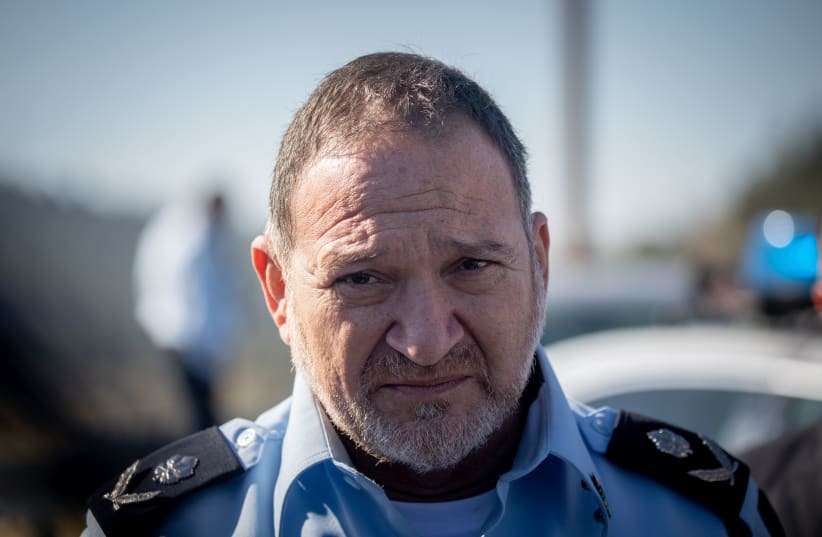Police Commissioner Kobi Shabtai shifted responsibility for the Lag Ba’omer Meron disaster onto Northern District Police Commander Shimon Lavi, in testimony before the commission of inquiry on Monday morning.
According to Shabtai, the Lag Ba’omer celebration in which 45 people died was a one-off event, like the Tel Aviv Marathon or the Western Wall Priestly Blessing (Birkat Cohanim).
“This is a district incident – it is under the command of the commander of that district,” Shabtai explained. “Even if there is help from other districts, there is an advantage to the cumulative experience of the district police officers.”
However, he emphasized that “Shimon Lavi is one of the most talented and experienced commanders in the Israel Police. I had full confidence in his skills and abilities, and I have full confidence in him even today. Shimon Lavi has proven and is proving every day his ability to face the challenges of a district commander, and he is bringing the district to remarkable achievements.”
Retired commander Amnon Alkalay, former head of the police operations division, testified that despite the recommendation of senior police officers on an outline restricting the crowd at each bonfire, Shabtai outright rejected it.


“He [Shabtai] said: ‘Either the mountain is completely open or closed,’” Alkalay said. “I warned them to prepare for a multi-casualty incident.”
He added that during the preparatory meeting for the incident, “the chief said: ‘If there is a commission of inquiry, come to me.’”
Shabtai rejected the main points made during Alkalay’s testimony.
According to Shabtai, the decision on the format of the restrictions was transferred to the political echelon, since “it is not the police who are authorized to decide whether there will be restrictions.”
In addition, Shabtai clarified that “the attempt to produce a dramatic discussion with [Alkalay’s] participation transgresses reality. His statements did not bring anything new. The issue of overcrowding was at the heart of the program and everyone addressed it. Neither the head of the operations division nor any other person had expressed any doubts or presented any failures in the plan, or an alternative plan. No operations division representative expressed any doubts or demanded corrections until the plan reached the national level.”
Shabtai further criticized the government’s performance on the problem.
“The inability of the various government ministries to reach an agreed wording of regulations was a clear expression and reflection of the basic difficulty that has accompanied the Meron event for years,” he said, an “inability, and perhaps unwillingness, of the political echelon to regulate the event, as well as physically regulating the site itself.”
THE POLICE chief said that in a discussion with the ministers and then-corona commissioner Prof. Nachman Ash, “the political echelon decided that the event would be in the format of an open mountain with no restrictions on the crowd’s entry..., but with a restriction at each bonfire.”
Shabtai said that police could not count the participants at the bonfires accurately, so they were aided by helicopters, quadcopters and cameras, and that the Dov Bridge, where the disaster occurred, is not part of the bonfire area but a side passage.
“What happened at that given moment that made people go I do not know,” said Shabtai. “For me, these are questions that remain open. They tried to regulate this mountain for a decade, but four government committees did not solve the problem. All the problems solved between the Northern District and the Holy Places Foundation are local initiatives of the Northern District.”
Shabtai said the failure that led to the disaster was related to engineering rather than police.
“Like in the Versailles wedding hall disaster and the Maccabiah disaster, it would not have happened if there were no people,” he testified, referring to the May 24, 2001, disaster in which 23 revelers at a wedding were killed, and the July 14, 1997, catastrophe at the opening of the Maccabiah Games when a bridge collapsed over the Yarkon River and four people were killed.
“For a disaster with an engineering failure to happen, it also needs density,” Shabtai said. “We did not know in advance about the failure at the Dov Bridge. I do not know what caused that crowd to run there. Even if there was a crowd and pressure, without the engineering failure there would have been no disaster – without the slipperiness and slope of the bridge. I am not a safety engineer and I do not cross every path and every bridge. We do not understand that. There were safety engineers who did it.”
The deliberations of the commission of inquiry have shown so far that the police had no choice but to serve as an integral part of the incident, but this, in turn, avoided restricting the visitors to the mountain despite all scenarios that warned of a disaster.
Apart from Lavi, who announced shortly after the incident that “I bear overall responsibility, for better or worse,” senior police officers who appeared before the committee refrained from saying so, and focused on action and moves they promoted for the well-being of those visiting Mount Meron.
Ash, who served as coronavirus commissioner during the disaster, pointed an accusing finger at the police and the Religious Services Ministry, which he said had avoided management of the incident. In a conversation with the police about keeping the restrictions set, Ash was told that they would “take care of it.”
“My feeling was that the outline was realistic, that there would be someone to enforce it,” he said.
Monday’s hearing follows dozens of witnesses and hundreds of hours of testimony that revealed the chain of failures in the May disaster.
